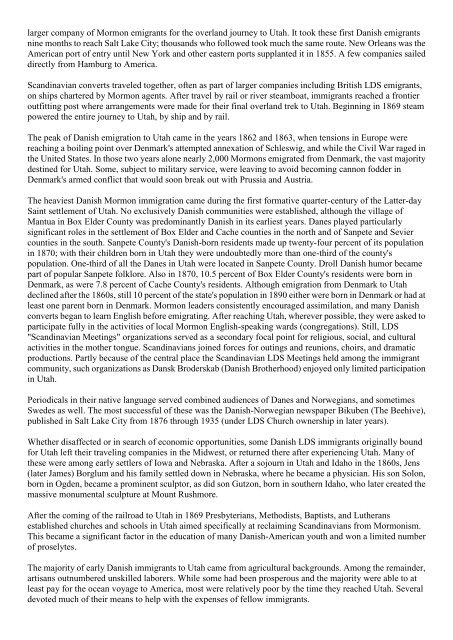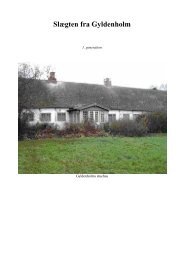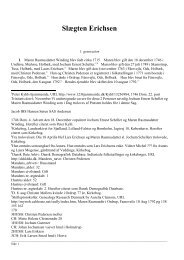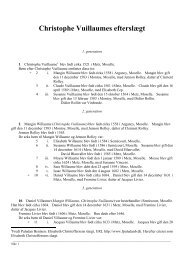Slægten fra Kongsgården - Myerichsen.net
Slægten fra Kongsgården - Myerichsen.net
Slægten fra Kongsgården - Myerichsen.net
Create successful ePaper yourself
Turn your PDF publications into a flip-book with our unique Google optimized e-Paper software.
larger company of Mormon emigrants for the overland journey to Utah. It took these first Danish emigrants<br />
nine months to reach Salt Lake City; thousands who followed took much the same route. New Orleans was the<br />
American port of entry until New York and other eastern ports supplanted it in 1855. A few companies sailed<br />
directly from Hamburg to America.<br />
Scandinavian converts traveled together, often as part of larger companies including British LDS emigrants,<br />
on ships chartered by Mormon agents. After travel by rail or river steamboat, immigrants reached a frontier<br />
outfitting post where arrangements were made for their final overland trek to Utah. Beginning in 1869 steam<br />
powered the entire journey to Utah, by ship and by rail.<br />
The peak of Danish emigration to Utah came in the years 1862 and 1863, when tensions in Europe were<br />
reaching a boiling point over Denmark's attempted annexation of Schleswig, and while the Civil War raged in<br />
the United States. In those two years alone nearly 2,000 Mormons emigrated from Denmark, the vast majority<br />
destined for Utah. Some, subject to military service, were leaving to avoid becoming cannon fodder in<br />
Denmark's armed conflict that would soon break out with Prussia and Austria.<br />
The heaviest Danish Mormon immigration came during the first formative quarter-century of the Latter-day<br />
Saint settlement of Utah. No exclusively Danish communities were established, although the village of<br />
Mantua in Box Elder County was predominantly Danish in its earliest years. Danes played particularly<br />
significant roles in the settlement of Box Elder and Cache counties in the north and of Sanpete and Sevier<br />
counties in the south. Sanpete County's Danish-born residents made up twenty-four percent of its population<br />
in 1870; with their children born in Utah they were undoubtedly more than one-third of the county's<br />
population. One-third of all the Danes in Utah were located in Sanpete County. Droll Danish humor became<br />
part of popular Sanpete folklore. Also in 1870, 10.5 percent of Box Elder County's residents were born in<br />
Denmark, as were 7.8 percent of Cache County's residents. Although emigration from Denmark to Utah<br />
declined after the 1860s, still 10 percent of the state's population in 1890 either were born in Denmark or had at<br />
least one parent born in Denmark. Mormon leaders consistently encouraged assimilation, and many Danish<br />
converts began to learn English before emigrating. After reaching Utah, wherever possible, they were asked to<br />
participate fully in the activities of local Mormon English-speaking wards (congregations). Still, LDS<br />
"Scandinavian Meetings" organizations served as a secondary focal point for religious, social, and cultural<br />
activities in the mother tongue. Scandinavians joined forces for outings and reunions, choirs, and dramatic<br />
productions. Partly because of the central place the Scandinavian LDS Meetings held among the immigrant<br />
community, such organizations as Dansk Broderskab (Danish Brotherhood) enjoyed only limited participation<br />
in Utah.<br />
Periodicals in their native language served combined audiences of Danes and Norwegians, and sometimes<br />
Swedes as well. The most successful of these was the Danish-Norwegian newspaper Bikuben (The Beehive),<br />
published in Salt Lake City from 1876 through 1935 (under LDS Church ownership in later years).<br />
Whether disaffected or in search of economic opportunities, some Danish LDS immigrants originally bound<br />
for Utah left their traveling companies in the Midwest, or returned there after experiencing Utah. Many of<br />
these were among early settlers of Iowa and Nebraska. After a sojourn in Utah and Idaho in the 1860s, Jens<br />
(later James) Borglum and his family settled down in Nebraska, where he became a physician. His son Solon,<br />
born in Ogden, became a prominent sculptor, as did son Gutzon, born in southern Idaho, who later created the<br />
massive monumental sculpture at Mount Rushmore.<br />
After the coming of the railroad to Utah in 1869 Presbyterians, Methodists, Baptists, and Lutherans<br />
established churches and schools in Utah aimed specifically at reclaiming Scandinavians from Mormonism.<br />
This became a significant factor in the education of many Danish-American youth and won a limited number<br />
of proselytes.<br />
The majority of early Danish immigrants to Utah came from agricultural backgrounds. Among the remainder,<br />
artisans outnumbered unskilled laborers. While some had been prosperous and the majority were able to at<br />
least pay for the ocean voyage to America, most were relatively poor by the time they reached Utah. Several<br />
devoted much of their means to help with the expenses of fellow immigrants.





